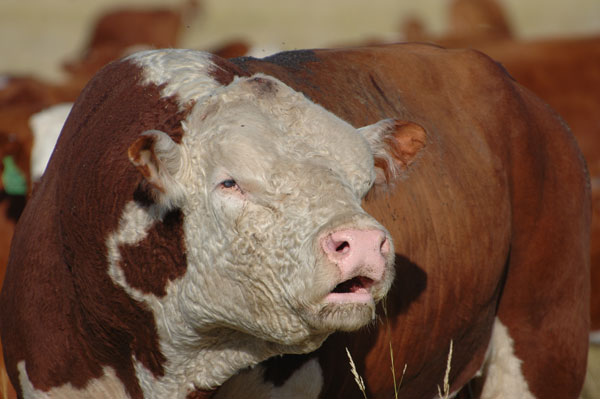Plan now to ensure your bulls are ready to go come turn-out time.
December 12, 2019

The value of a bull is a variable equation to variable producers. But much like a piece of machinery or a tract of land, it is relatable to return on investment. A basic requirement of the cow-calf business is to make sure each female has a healthy calf that weighs to its full potential every calendar year.
But before that can happen, a calculated investment in a well-managed virile bull and the infrastructure and management to maintain him properly and safely through the offseason is necessary. This is nothing new or earth shattering, but if the bull is defective, becomes damaged goods or is otherwise mishandled, there can be large financial consequences.
Protect the goods
Winter can be a stressful time for cattle. In colder areas of the country, it is essential to provide protection from extreme and volatile weather as the opportunity for frost-bitten testicles is always high. Brett Andrews of Burwell Nebraska Veterinary Hospital encourages producers to keep bulls where shelter, trees or man-made windbreaks are available to block the north winds that can cause frost or freeze damaged scrotums.
“Provide bedding during the severest cold or blizzard conditions so the scrotums won’t be on the bare, cold ground. The producers who do this have very few permanent testicular injuries due to extreme cold. However, I have seen bulls that were left out with no or minimal shelter and they suffered permanent testicular injury.”
Crunch the numbers
Hypothetically, consider that a single herd bull sires 120 calves in his working life over the course of four years, improving the weight yield of calves sold at weaning by a 15-pound average at $1.50 per pound. This scenario will increase the bottom line by $2,700 over the bull’s productive lifetime. On top of this is the value of any females kept as replacements during the four years.
If a third of the approximately 60 heifers are kept from a 100-head female herd, the derivative economic effect of the bull buying ability is 20% of the annual profit and loss statement. Not to be forgotten, of course, an average salvage value for a mature bull should yield in the $2,000 range.
On the negative side, if the bull is the cause of one cow going un-bred through her first cycle and becoming pregnant during her next estrus cycle, on an average year, it can cost the producer close to $100 on lost weaning weight of that calf alone. Factored over numerous cows, the losses become exponentially large. When running the numbers, it is undeniable that the management of this bull is a vital component of the operation’s overall health.
Preserve the conditioning
With bulls that are held over, it is extremely important to complete the normal procedures of the breeding soundness exam (BSE), vaccination, feet trimming and a trichomoniasis test. Pencil out the bull power needed per cow and beyond that, the focus should be on body conditioning.
Tom Troxel Ph.D., at the University of Arkansas, states it is important to divide bulls into management groups in order to more effectively meet dietary needs. “Separating younger and older bulls may be particularly important in preventing injuries and meeting nutritional requirements.”
Younger bulls are growing rapidly and will need a different diet to compensate their growth rate and to replace the condition they lost during a previous breeding season. He suggests that herd bulls be kept in a separate location away from cows, heifers and younger bulls, with plenty of exercise room, clean water and mineral supplements.
A body conditioning score of 5 or slightly higher is optimal before bulls are turned out, as during the breeding season, bulls can lose up to 3 pounds per day. Thus it is essential for all ages to enter this period in peak physical condition.
Make the sort
As winter retreats and spring approaches, the smell of females in the air can once again destroy the tentative peace and confrontations may begin. The readiness to rearrange existing bulls by ages, size or personalities, along with the facilities to accommodate this, are vital.
Bulls that will later be combined in multi-sire breeding pastures should be penned together for several weeks before the season begins to allow the inevitable re-establishment of the social pecking order. This will create a large enough cushion of time should injuries occur and a replacement bull be required. Bulls WILL establish and re-establish social order, but a producer can manipulate the process to avoid a damaged goods situation.
Have a Plan B
Unfortunately, no system is perfect, so it is important to have a Plan B, but it should never be the unknown hold-over bull dumped at the local auction barn. The negatives of this mystery bull could be very costly.
If possible, having an extra suitable bull is wise, or pencil in a potential quality replacement that might be available at short notice. These days there is no reason to purchase inferior and unknown bulls.
For all involved, it is the goal to have fit and healthy bulls ensuring pregnant females as early in the breeding season as possible, plus have these bulls in optimal condition throughout the off season, ensuring their readiness when called upon in the upcoming year.
Derksen is a freelance writer and feedyard pen rider in Lacombe, Alberta, Canada.
You May Also Like



